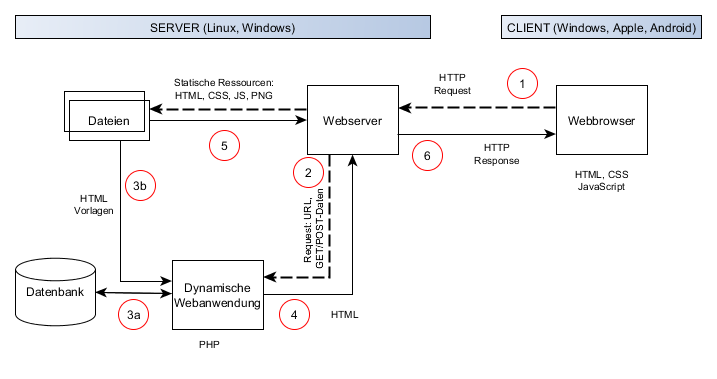Web Technologies and Cloud Computing
HTML, CSS, JavaScript, PHP Web Frameworks Web Services Cloud
This course at Master's level gives an introduction to the theoretical and practical basics of modern web and cloud technologies.
Content
Topics include
- Structure of the Internet and the WWW
- Static and dynamic websites, server and client-side programming
- Web frameworks: Java-based, PHP-based
- Web services and service-oriented architectures: REST and SOAP
- What is cloud computing? Basic technical terms, service models and operator models
- Basic cloud technologies: platform and application virtualization
- Cloud architecture and frameworks, platforms: Amazon AWS and Google Cloud

The course description in German can be found on the Campusboard-platform of the university.
Learning goals
On completion of this course you should be able to:
- explain the languages and transmission protocols of the WWW service, in particular: HTTP protocol, URL, HTML document, web browser, web server
- explain what a web application is and describe how a web application works using the request-response lifecycle.
- describe the difference between a static and a dynamic web application.
- select the appropriate languages, frameworks and components for creating web applications for a specific use case.
- specify the definition, classification, applications and areas of application of web services.
- describe the difference between a SOAP-based and a RESTful web service.
- describe what is meant by cloud computing and what the characteristic properties, service and operator models of cloud computing are.
- list the most important basic technologies that form the basis of cloud computing, in particular computer and storage virtualization and application virtualization.
- use and configure cloud services of the Amazon AWS cloud platform.
Literature
Here a selection of recommended readings.
- 1. Erl, Thomas; Mahmood, Zaigham; Puttini, Ricardo (2013): Cloud computing. Concepts, technology and architecture. Prentice-Hall.
- 2. Fox, Armando; Patterson, David (2016): Engineering Software as a Service.
- 3. Jackson JC (2007) Web technologies. A computer science perspective. Pearson/Prentice Hall
- 4. Wagner G, Diaconescu M (2017) Developing Web Applications. With UML using Java and JavaScript. De Gruyter Textbook.
Software
As software, we use mainly XAMPP with MySQL / MariaDB and phpMyAdmin as user interface.
- MySQL (as part of XAMPP)
MySQL or the newer MariaDB are open source databases used frequently in web applications. For development purposes, we use the XAMPP-package, that contains the Apache Webserver, Tomcat, PHP and also phpMyAdmin as management user interface for the DBMS. - yED Graph Editor
With yED, we develop ER and UML-diagrams.